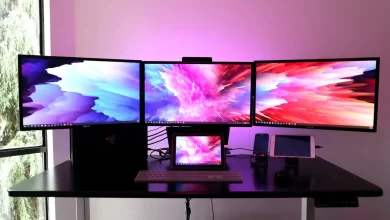Windows, in the context of computing, are graphical user interface elements that provide a visual way for users to interact with a computer’s operating system and software applications. They consist of graphical elements such as buttons, icons, and menus, displayed on a computer screen. Windows allow users to open, close, resize, and arrange applications and files, making it easier to multitask and manage their digital workspace. The concept of windows revolutionized the way people interacted with computers, providing a more intuitive and user-friendly experience. Today, Windows-based operating systems, developed by Microsoft, are among the most widely used in the world, powering countless personal computers and devices.
- First Version: The first version of Windows, Windows 1.0, was released in 1985. It was more of a graphical shell for MS-DOS than a standalone operating system.
- Name Origin: The name “Windows” was chosen because of the operating system’s primary feature: the ability to open multiple graphical windows on the screen.
- Successive Versions: Windows has gone through many iterations, with notable versions including Windows 3.1, Windows 95, Windows XP, Windows 7, Windows 8, and Windows 10. Windows 11 is the latest version.
- Start Menu: The Start menu, a hallmark feature of Windows for many years, was introduced in Windows 95. It provided a central location for accessing programs and files.
- Blue Screen of Death (BSOD): The infamous “Blue Screen of Death” is a system error screen displayed in Windows when the operating system encounters a critical error. It has become a symbol of computer crashes.
- Bill Gates’ “Ctrl+Alt+Delete”: To log in to Windows in the early days, users had to press “Ctrl+Alt+Delete.” Bill Gates has famously referred to this as a “mistake” but also acknowledged that it was a security feature.
- Windows XP’s Popularity: Windows XP, released in 2001, became incredibly popular and was used by millions of people worldwide for many years. It is still fondly remembered by many users.
- Windows 95’s Launch: The launch of Windows 95 was a major event, complete with a massive marketing campaign and a promotional video featuring the song “Start Me Up” by The Rolling Stones.
- Cortana: Windows 10 introduced Cortana, a virtual assistant similar to Apple’s Siri. Cortana can perform tasks, answer questions, and assist with various functions on the computer.
- Microsoft Edge: Windows 10 replaced Internet Explorer with Microsoft Edge as the default web browser. Edge was designed to be faster and more modern, competing with other popular browsers like Chrome and Firefox.
- Universal Windows Platform (UWP): UWP is a framework that allows developers to create applications that can run on multiple Windows 10 devices, from PCs to Xbox consoles.
- DirectX: Microsoft developed DirectX, a collection of APIs (Application Programming Interfaces), to support multimedia and gaming on Windows. It has played a crucial role in the gaming industry.
- Windows Insider Program: Microsoft introduced the Windows Insider Program, allowing users to test pre-release versions of Windows and provide feedback to help shape the final product.
- Market Dominance: Windows has been the dominant desktop operating system for many years, with a significant share of the global market.
- Windows Subsystem for Linux (WSL): Windows 10 introduced WSL, allowing users to run a Linux distribution alongside Windows, providing more flexibility for developers and users.
- Windows Store: Windows 8 introduced the Windows Store, a digital distribution platform for apps, games, and other content. It’s similar to app stores on mobile devices.
- Windows on Mobile: Microsoft attempted to enter the mobile market with Windows Phone, but it faced tough competition from iOS and Android and ultimately discontinued the platform in favor of integrating some features into Windows 10 Mobile.
- Windows Activation: Windows requires activation using a product key to verify its legitimacy. This measure helps prevent software piracy.
- Windows Server: Microsoft offers Windows Server editions tailored for enterprise and data center environments. These versions provide features for managing networks, servers, and cloud services.
- Windows Mixed Reality: Windows 10 introduced support for mixed reality headsets, allowing users to experience a blend of virtual reality and augmented reality applications.
- Long-Term Servicing Channel (LTSC): Microsoft offers LTSC versions of Windows, designed for critical systems that need stability and long-term support. These versions receive updates less frequently compared to standard editions.
- Windows 10X: Microsoft announced Windows 10X, a version of Windows optimized for dual-screen devices, but it was later canceled in favor of integrating its features into Windows 11.
- Windows as a Service (WaaS): With Windows 10, Microsoft adopted a “Windows as a Service” approach, providing regular feature updates and security patches rather than releasing entirely new versions of the operating system.
- Accessibility Features: Windows includes a range of accessibility features, including screen readers, magnification tools, and speech recognition, to make the OS more inclusive.
- Windows Hello: Windows 10 introduced Windows Hello, a biometric authentication system that allows users to log in using facial recognition or a fingerprint scanner.
- Windows File Explorer: File Explorer is the default file management tool in Windows, providing users with a way to browse and organize their files and folders.
- Parental Controls: Windows offers parental control features that allow parents to restrict their children’s access to certain apps, websites, and features.
- File History: Windows 8 and later versions include File History, a feature that automatically backs up files and versions to an external drive, making it easier to recover lost or changed files.






